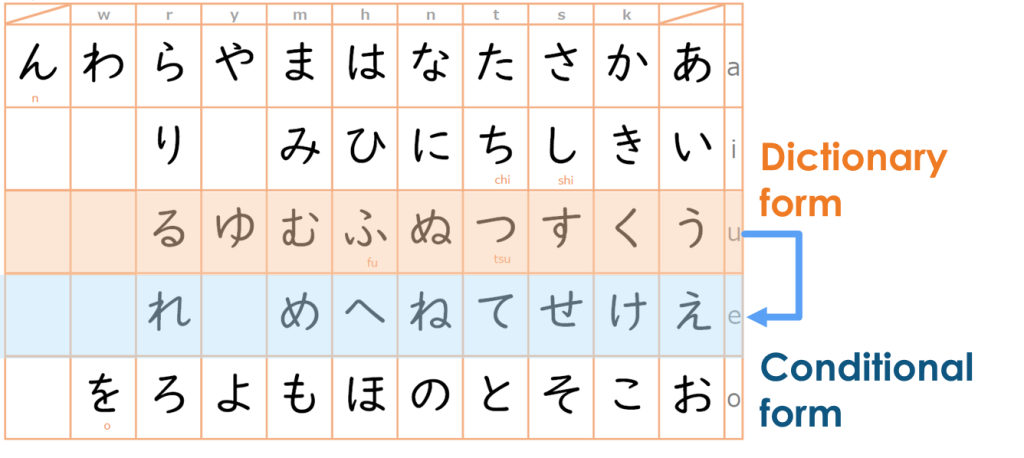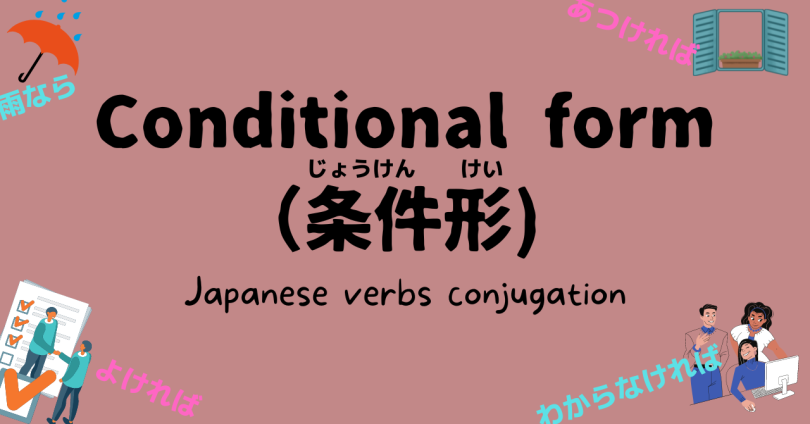The world is full of conditions! So it is necessary to speak about conditions in Japanese.In addition, there are many situations in Japanese where we speak of preliminaries, giving the impression of politeness. The conditionals are used a lot in such cases.
Today we will learn together how to make the conditional form and how to use it through example sentences.
Table of contents
How to make Conditional form?
First, Divide verbs into groups as usual. If you are faced with a new verb and are stumped as to how to divide the group, check here.
Next, I will explain how to convert Dictionary form to Potential verbs.
GroupⅡ/ Ru-verbs
たべ
る remove, add れば.る→ たべ れば
Group II is always easy! Say goodbye to ”Ru”and add ”reba”.
Group Ⅲ / Irregular verbs
す
る remove, add ればる→ すれば
く
る remove, add ればる→ くれば
Group III has the same rules as Group II.
Group Ⅰ / U-verbs
The problem is Group I. But it’s ok. Everyone, please think of the hiragana chart.
For example,
あう → あえれば
“う” changes to “え”. And add “れば”
かく → かければ
“く” changes to “け”. And add “れば”
This movement is with the potential verbs.

In Group I (U-verbs), there is always an “u-line” if it’s dictionary form. When making Potential verbs, it changes to “e-line”.
Conditional forms are also present in nouns and adjectives. See the table below.
| Affirmative | Negative | |
|---|---|---|
| Verb | 見(み)れば (見る) | 見(み)なければ (見ない) |
| イA | さむければ (さむい) よければ (いい) | さむくなければ (さむくない) よくなければ (よくない) |
| ナA | 元気(げんき)なら (元気な) | 元気(げんき)じゃなければ (元気じゃない) |
| N | 雨(あめ) なら | 雨(あめ)じゃなければ |
Useful pharases with Conditional form
Here’s an example sentence! Think of all the uses, all the situations!
走(はし)れば、電車(でんしゃ) に 間に合う(まにあう)!
If you run, you can catch the train!
(V) はしる → はしれば
わからなければ、いつでも聞(き)いて。
If you don’t understand, ask me anytime.
(V) わからない → わからなければ
あつければ、まどを あけてください。
If it is hot, open the window.
(イA) あつい → あつければ
いそがしくなければ、一緒(いっしょ)に行(い)きませんか。
If you are not busy, would you like to go with me?
(イA) いそがしくない → いそがしくなければ
暇(ひま) なら、明日(あした)、あそぼう。
If you are free, let’s hang out tomorrow.
(ナA) ひま → ひまなら
しずかじゃなければ、寝(ね)られない。
If it’s not quiet, I can’t sleep.
(ナA) しずかじゃない → しずかじゃなければ
雨(あめ)なら、ハイキングは中止(ちゅうし)です。
If it rains, the hike is canceled.
(N) 雨(あめ) → 雨(あめ)なら
日本じゃなければ、この景色(けしき)は 見られません。
If it is not in Japan, you will not be able to see this view.
(N) 日本 → 日本じゃなければ
More about Japanese grammar
At the Pre-intermediate level, you will learn many expressions with a narrower range of meaning than at the beginner level. This Grammar Expressions Dictionary is very useful at that time. You can use it like a dictionary for example sentences and detailed explanations of conjunctions.
A Dictionary of Basic Japanese Grammar 日本語基本文法辞典 Kindle Edition
How to practice Conditional form?
Step1. Proper understanding of rules
Surely, it seems obvious, doesn’t it? However, when different conjugations such as Negative form and Te form are introduced in the future, different rules will be used and many new verbs will be introduced. Therefore, it is important to firmly input “This is the rule for Dictionary form”.
Step2. Repeat until reflexive
In the beginning, You will think…”Which group is this verb?” ,and then if it is Group I, You will remind that “What is the letter before Masu…..?”.It is the right process. However, when it comes to real conversation, there is no time to think about it. You need to respond reflexively, i.e., within 1-2 seconds.
Definitely,if you want to be able to speak, this time lag can be a problem.So, for this kind of conjugate memorization, use flashcards.The recommended app is Anki. If you haven’t used it yet, please also read this article.







